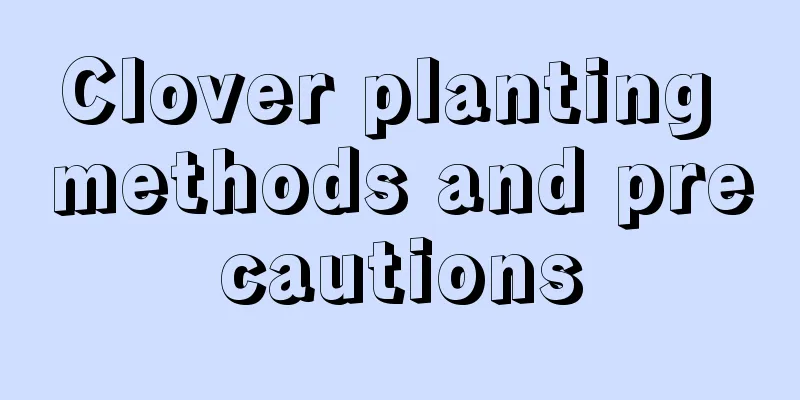Clover planting methods and precautions

|
Clover, also known as clover, is a perennial herb of the genus Trifolium in the Leguminosae family. It grows strongly and has dense plants, making it very suitable for group planting and landscaping. It has high ornamental value, can be used as medicine, and has a wide range of uses. Let's talk about the planting methods and precautions of clover. 1. Soil selection When planting clover, you should use loose, fine and flat soil. Its seeds are very small. If the cultivation soil is too sticky, it will hinder its growth and development. In addition, it is best if the soil contains rich organic matter, which can make the plants grow more vigorously. 2. Appropriate fertilization Clover itself has a certain ability to fix nitrogen, and applying an appropriate amount of nitrogen fertilizer can make the seedlings grow stronger. When it grows and matures, you should apply more phosphorus and potassium fertilizers. In addition, nitrogen fertilizer helps its growth, and phosphorus and potassium fertilizers have the effect of increasing production. The amount of nitrogen fertilizer applied in the later stage must not be too much. 3. Water in time Clover likes to grow in humid places, so it should be watered in time during maintenance and the soil should be kept slightly moist. However, there should not be water accumulation in the potting soil, because if the amount of water is too much, its roots will rot due to poor breathing, and the plant will die. 4. Reasonable lighting Clover can be placed in a relatively bright and well-lit place for maintenance in spring, autumn and winter. Especially in winter, giving clover more sunlight will help it survive the winter. It should not be exposed to the sun for a long time in summer, especially the midday sun, which is very strong, so it should be kept in a cool place. 5. Suitable temperature Clover is a thermophilic plant that grows vigorously in summer and slowly in winter. The most suitable growth temperature for it is around 18-30 degrees. 6. Pest and disease control Clover is rarely attacked by pests and diseases, but it may also be harmed by powdery mildew or brown spot disease. Once the disease occurs, it cannot be ignored and should be sprayed with pesticides in time. It is recommended to use Bordeaux mixture or carbendazim for spraying. If scale insects occur, omethoate can be used for spraying. That’s it |
<<: How to deal with the small lily after it blooms and how to cut it
>>: How to divide the miniature coconut palm and when is the best time to divide it into pots
Recommend
How to care for freesia after it blooms
1. Pruning and maintenance After the freesia has ...
Can Kalanchoe be placed in the bedroom?
1. Toxic More and more people are discussing whet...
How often should I water the soil-grown green radish?
How often should I water the soil-grown green rad...
Do one more thing by watering, and the flowers will grow 10 times faster than others!
1. Drying in tap water The temperature is so high...
The role of Japanese cherry blossoms
The ornamental value of Japanese late cherry blos...
Can I grow hyacinths if there is a pregnant woman at home?
Can I raise a baby if there is a pregnant woman a...
Can Epiphyllum be watered with beer water?
Can Epiphyllum be watered with beer water? Epiphy...
What flowers are suitable for growing in Xing'an League? What are the city flowers and trees?
1. Climate characteristics of Xing'an League ...
Can chrysanthemums be exposed to rain? Can potted chrysanthemums be exposed to rain outdoors?
Whether chrysanthemums are afraid of water depend...
How to care for chrysanthemums in summer?
Chrysanthemum Care Water Management The amount an...
Is Daphne odora poisonous?
Is Osmanthus fragrans poisonous? Rumors are just ...
How often should I water the copper green unicorn?
1. How often should I water the plant? When the c...
Are rose pots suitable for deep or shallow pots?
Should I use a deep or shallow pot for roses? It ...
Rose flower language and meaning
1. Flower Language Roses have different colors, a...
Where do pistachios grow? What kind of tree is it? Where do pistachio trees grow?
What tree does the pistachio grow on? Pistachio i...









